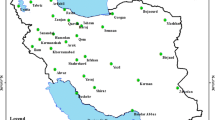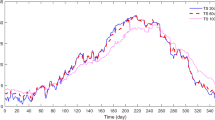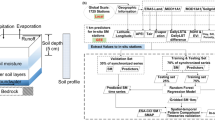Abstract
This study presents the first-time application of a novel emotional neural network (ENN) for soil temperature modeling. Two scenarios were considered for soil temperature forecasting: (i) meteorological variable-based modeling and (ii) time series-based modeling. For the first scenario, meteorological variables, including average air temperature, average wind speed, and total solar radiation, were considered as the inputs of a predictor model, while for the second one, the time delays of the soil temperature time series were considered as input(s) for forecasting future time-step soil temperature profiles. The multi-depth daily soil temperature datasets from Springfield and Champaign stations, located in Illinois, USA, were collected at the 10-cm and 20-cm depths to evaluate the proposed model. Moreover, the proposed ENN model was compared with other popular modeling techniques, including generic programming (GA), least square support vector machine (LSSVM), and multivariate adaptive regression splines (MARS). These case studies indicate the superior performance of the ENN compared to other popular modeling techniques for soil temperature applications. The mean relative error of scenario 2 was in the 5–7% range, while it was more than 40% for scenario 1.










Similar content being viewed by others
Data availability
Data provided by the Water and Atmospheric Resources Monitoring Program, a part of the Illinois State Water Survey (ISWS) located in Champaign and Peoria, Illinois, and on the web at isws.illinois.edu/warm.
References
Allmaras RR, Burrows WC, Larson WE (1964) Early growth of corn as affected by soil temperature. Soil Sci Soc Am J 28(2):271–275. https://doi.org/10.2136/sssaj1964.03615995002800020041x
Anwar SA, Zakey AS, Robaa SM, Wahab MA (2018) The influence of two land-surface hydrology schemes on the regional climate of Africa using the RegCM4 model. Theor Appl Climatol. https://doi.org/10.1007/s00704-018-2556-8
Azimi H, Bonakdari H, Ebtehaj I, Michelson DG (2018) A combined adaptive neuro-fuzzy inference system–firefly algorithm model for predicting the roller length of a hydraulic jump on a rough channel bed. Neural Comput Appl 29(6):249–258. https://doi.org/10.1007/s00521-016-2560-9
Azimi H, Bonakdari H, Ebtehaj I (2021) Gene expression programming-based approach for predicting the roller length of a hydraulic jump on a rough bed. ISH J Hydraulic Eng 27(sup1):77–87. https://doi.org/10.1080/09715010.2019.1579058
Béhaegel M, Sailhac P, Marquis G (2007) On the use of surface and ground temperature data to recover soil water content information. J Appl Geophys 62:234–243. https://doi.org/10.1016/j.jappgeo.2006.11.005
Berry EC, Radke JK (1995) Biological processes: relationships between earthworms and soil temperatures. J Minn Acad Sci 59:6–8
Bonakdari H, Moeeni H, Ebtehaj I, Zeynoddin M, Mahoammadian A, Gharabaghi B (2018) New insights into soil temperature time series modeling: linear or nonlinear? Theor Appl Climatol. https://doi.org/10.1007/s00704-018-2436-2
Bonakdari H, Moeeni H, Ebtehaj I, Zeynoddin M, Mahoammadian A, Gharabaghi B (2019) New insights into soil temperature time series modeling: linear or nonlinear? Theor Appl Climatol 135(3):1157–1177. https://doi.org/10.1007/s00704-018-2436-2
Craven P, Wahba G (1978) Smoothing noisy data with spline functions: estimating the correct degree of smoothing by the method of generalized cross-validation. Numer Math 31:377–403. https://doi.org/10.1007/BF01404567
Dai Q, Guo L (2019) Two novel hybrid self-organizing map based emotional learning algorithms. Neural Comput Appl 31:2921–2938. https://doi.org/10.1007/s00521-017-3240-0
Ebtehaj I, Bonakdari H (2013) Evaluation of sediment transport in sewer using the artificial neural network. Eng Appl Comp Fluid 7(3):382–392. https://doi.org/10.1080/19942060.2013.11015479
Ebtehaj I, Bonakdari H, Gharabaghi B (2019) A reliable linear method for modeling lake level fluctuations. J Hydrol 570:236–250. https://doi.org/10.1016/j.jhydrol.2019.01.010
Ebtehaj I, Bonakdari H, Shamshirband S (2016a) Extreme learning machine assessment for estimating sediment transport in open channels. Eng Comput 32(4):691–704. https://doi.org/10.1007/s00366-016-0446-1
Ebtehaj I, Bonakdari H, Zaji AH (2018) A new hybrid decision tree method based on two artificial neural networks for predicting sediment transport in clean pipes. Alexandria Eng J 57(3):1783–1795. https://doi.org/10.1016/j.aej.2017.05.021
Ebtehaj I, Sattar AM, Bonakdari H, Zaji AH (2016b) Prediction of scour depth around bridge piers using self-adaptive extreme learning machine. J Hydroinform 19(2):207–224. https://doi.org/10.2166/hydro.2016.025
El-Saify MH, El-Garhy AM, El-Sheikh GA (2017) Brain emotional learning based intelligent decoupler for nonlinear multi-input multi-output distillation columns. Math Probl Eng. https://doi.org/10.1155/2017/8760351
Ferguson G, Beltrami H (2006) Transient lateral heat flow due to land-use changes. Earth Planet Sci Lett 242:217–222. https://doi.org/10.1016/j.epsl.2005.12.001
Friedman JH (1991) Multivariate adaptive regression splines. Ann Stat 19(1):1–67. https://www.jstor.org/stable/2241837. Accessed March 1991
Gharabaghi B, Safadoust A, Mahboubi AA, Mosaddeghi MR, Unc A, Ahrens B, Sayyad G (2015) Temperature effect on the transport of bromide and E. coli NAR in saturated soils. J Hydrol 522:418–427. https://doi.org/10.1016/j.jhydrol.2015.01.003
Gholami A, Bonakdari H, Ebtehaj I, Akhtari AA (2017) Design of an adaptive neuro-fuzzy computing technique for predicting flow variables in a 90 sharp bend. J Hydroinf 19(4):572–585. https://doi.org/10.2166/hydro.2017.200
Gholami A, Bonakdari H, Ebtehaj I, Gharabaghi B, Khodashenas SR, Talesh SHA, Jamali A (2018) A methodological approach of predicting threshold channel bank profile by multi-objective evolutionary optimization of ANFIS. Eng Geol 239:298–309. https://doi.org/10.1016/j.enggeo.2018.03.030
Gholami A, Bonakdari H, Zeynoddin M, Ebtehaj I, Gharabaghi B, Khodashenas SR (2019) Reliable method of determining stable threshold channel shape using experimental and gene expression programming techniques. Neural Comput Appl 31(10):5799–5817. https://doi.org/10.1007/s00521-018-3411-7
Ghuman BS, Lal R (1982) Temperature regime of a tropical soil in relation to surface condition and air temperature and its Fourier analysis. Soil Sci 134:133–140. https://doi.org/10.1097/00010694-198208000-00008
Grégoire G, Fortin J, Ebtehaj I, Bonakdari H (2022) Novel hybrid statistical learning framework coupled with random forest and grasshopper optimization algorithm to forecast pesticide use on golf courses. Agriculture 12(7):933. https://doi.org/10.3390/agriculture12070933
Gupta SC, Radke JK, Larson WE (1981) Predicting temperatures of bare and residue covered soils with and without a corn crop. Soil Sci Soc Am J 45:405–412. https://doi.org/10.2136/sssaj1981.03615995004500020034x
Hiraiwa Y, Kasubuchi T (2000) Temperature dependence of thermal conductivity of soil over a wide range of temperature (5–75°C). Eur J Soil Sci 51:211–218. https://doi.org/10.1046/j.1365-2389.2000.00301.x
Kang S, Kim S, Oh S, Lee D (2000) Predicting spatial and temporal patterns of soil temperature based on topography, surface cover and air temperature. Fore Ecol Manage 36:173–184. https://doi.org/10.1016/S0378-1127(99)00290-X
Keryn IP, Polglase PJ, Smethurst PJ (2004) Soil temperature under forests: a simple model for predicting soil temperature under a range of forest types. Agric Forest Meteorol 121:167–182. https://doi.org/10.1016/j.agrformet.2003.08.030
Khashman A (2008) A modified back propagation learning algorithm with added emotional coefficients. IEEE T Neural Networ 19(11):1896–1909. https://doi.org/10.1109/TNN.2008.2002913
Khashman A (2009) Application of an emotional neural network to facial recognition. Neural Comput Appl 18(4):309–320. https://doi.org/10.1007/s00521-008-0212-4
Khashman A (2010) Modeling cognitive and emotional processes: a novel neural network architecture. Neural Netw 23(10):1155–1163. https://doi.org/10.1016/j.neunet.2010.07.004
Khashman A (2011) Credit risk evaluation using neural networks: emotional versus conventional models. Appl Soft Comput 11(8):5477–5484. https://doi.org/10.1016/j.asoc.2011.05.011
Khozani ZS, Bonakdari H, Ebtehaj I (2017) An analysis of shear stress distribution in circular channels with sediment deposition based on Gene Expression Programming. Int J Sediment Res 32(4):575–584. https://doi.org/10.1016/j.ijsrc.2017.04.004
Kim S, Singh VP (2014) Modeling daily soil temperature using data-driven models and spatial distribution. Theor Appl Climatol 118(3):465–479. https://doi.org/10.1007/s00704-013-1065-z
Langholz H (1989) A simple model for predicting daily mean soil temperatures. J Agron Crop Sci 163:312–318. https://doi.org/10.1111/j.1439-037X.1989.tb00773.x
Lotfi E, Khosravi A, Nahavandi S (2017) Facial emotion recognition using emotional neural network and hybrid of fuzzy c-means and genetic algorithm. In: IEEE International Conference on Fuzzy Systems (FUZZ-IEEE), pp 1–6. https://doi.org/10.1109/FUZZ-IEEE.2017.8015591
Lotfi N, Lotfi E, Mirzaei R, Khosravi A, Nahavandi S (2016) Nonlinear programming problem solving based on winner take all emotional neural network for tensegrity structure design. In: International Joint Conference on Neural Networks (IJCNN), pp 826–831. https://doi.org/10.1109/IJCNN.2016.7727285
Malik A, Tikhamarine Y, Sihag P, Shahid S, Jamei M, Karbasi M (2022) Predicting daily soil temperature at multiple depths using hybrid machine learning models for a semi-arid region in Punjab. India Environ Sci Pollut Res 29:71270–71289. https://doi.org/10.1007/s11356-022-20837-3
Manrique LA (1990) Estimating soil surface temperatures under different crop covers in Hawaii. Commun Soil Sci Plant Anal 21:2105–2117. https://doi.org/10.1080/00103629009368362
Mehdizadeh S, Behmanesh J, Khalili K (2017) Evaluating the performance of artificial intelligence methods for estimation of monthly mean soil temperature without using meteorological data. Environ Earth Sci 76(8):325. https://doi.org/10.1007/s12665-017-6607-8
Mehdizadeh S, Mohammadi B, Pham QB, Khoi DN, Linh NTT (2020) Implementing novel hybrid models to improve indirect measurement of the daily soil temperature: Elman neural network coupled with gravitational search algorithm and ant colony optimization. Measurement 165:108127. https://doi.org/10.1016/j.measurement.2020.108127
Mialon A, Richaume P, Leroux D, Bircher S, Al Bitar A, Pellarin T, Wigneron JP, Kerr YH (2015) Comparison of Dobson and Mironov dielectric models in the SMOS soil moisture retrieval algorithm. IEEE T Geosci Remote 53(6):3084–3094. https://doi.org/10.1109/TGRS.2014.2368585
Moeeni H, Bonakdari H, Ebtehaj I (2017) Monthly reservoir inflow forecasting using a new hybrid SARIMA genetic programming approach. J Earth Syst Sci 126(2):18. https://doi.org/10.1007/s12040-017-0798-y
Molajou A, Nourani V, Afshar A, Khosravi M, Brysiewicz A (2021) Optimal design and feature selection by genetic algorithm for emotional artificial neural network (EANN) in rainfall-runoff modeling. Water Resour Manage 35(8):2369–2384. https://doi.org/10.1007/s11269-021-02818-2
MorÉn CBJ (2001) Emotional learning: a computational model of the amygdala. Cybernet Syst 32(6):611–636
Nash JE, Sutcliffe JV (1970) River flow forecasting through conceptual models part I—a discussion of principles. J Hydrol 10:282–290. https://doi.org/10.1016/0022-1694(70)90255-6
Nourani V (2017) An Emotional ANN (EANN) approach to modeling rainfall-runoff process. J Hydrol 544:267–277. https://doi.org/10.1016/j.jhydrol.2016.11.033
Ozturk M, Salman O, Koc M (2011) Artificial neural network model for estimating the soil temperature. Can J Soil Sci 91(4):551–562. https://doi.org/10.4141/cjss10073
Parton WJ (1984) Predicting soil temperatures in a shortgrass steppe. Soil Sci 138:93–101
Paul KI, Polglase PJ, Smethurst PJ, Anthony MO, Carlyle CJ, Khannaa PK (2004) Soil temperature under forests: a simple model for predicting soil temperature under a range of forest types. Agri Forest Meteorol 121:167–182. https://doi.org/10.1016/j.agrformet.2003.08.030
Pollack HN, Smerdon JE, Van Keken PE (2005) Variable seasonal coupling between air and ground temperatures: a simple representation in terms of subsurface thermal diffusivity. Geophys Res Lett 32:L15405. https://doi.org/10.1029/2005GL023869
Post FA, Dreibelbis HC (1942) Some influence of frost penetration and microclimate on the water relationships of woodland, pasture and cultivated soil. Soil Sci Soc Am J 7:95–104
Reddy BSN, Pramada SK, Roshni T (2021) Monthly surface runoff prediction using artificial intelligence: a study from a tropical climate river basin. J Earth Syst Sci 130:35. https://doi.org/10.1007/s12040-020-01508-8
Reimer A, Shaykewich CF (1980) Estimation of Manitoba soil temperatures from atmospheric meteorological measurements. Can J Soil Sci 60:299–309. https://doi.org/10.4141/cjss80-033
Safadoust A, Amiri Khaboushan E, Mahboubi AA, Gharabaghi B, Mosaddeghi MR, Ahrens B, Hassanpour Y (2016a) Comparison of three models describing bromide transport affected by different soil structure types. Arch Agron Soil Sci 62(5):674–687. https://doi.org/10.1080/03650340.2015.1074184
Safadoust A, Doaei N, Mahboubi AA, Mosaddeghi MR, Gharabaghi B, Voroney P, Ahrens B (2016b) Long-term cultivation and landscape position effects on aggregate size and organic carbon fractionation on surface soil properties in semi-arid region of Iran. Arid Land Res Manag 30(4):345–361. https://doi.org/10.1080/15324982.2015.1016244
Shaghaghi S, Bonakdari H, Gholami A, Ebtehaj I, Zeinolabedini M (2017) Comparative analysis of GMDH neural network based on genetic algorithm and particle swarm optimization in stable channel design. Appl Math Comput 313:271–286. https://doi.org/10.1016/j.amc.2017.06.012
Sharafi H, Ebtehaj I, Bonakdari H, Zaji AH (2016) Design of a support vector machine with different kernel functions to predict scour depth around bridge piers. Nat Hazards 84(3):2145–2162. https://doi.org/10.1007/s11069-016-2540-5
Sihag P, Esmaeilbeiki F, Singh B, Ebtehaj I, Bonakdari H (2019) Modeling unsaturated hydraulic conductivity by hybrid soft computing techniques. Soft Comput 23(23):12897–12910. https://doi.org/10.1007/s00500-019-03847-1
Singh VK, Singh BP, Kisi O, Kushwaha DP (2018) Spatial and multi-depth temporal soil temperature assessment by assimilating satellite imagery, artificial intelligence and regression based models in arid area. Comput Electron Agr 150:205–219. https://doi.org/10.1016/j.compag.2018.04.019
Suykens JAK, De Barbanter J, Lukas L, Vandewalle J (2002) Weighted least squares support vector machines: robustness and sparse approximation. Neurocomput 48(1–4):85–105. https://doi.org/10.1016/S0925-2312(01)00644-0
Tabari H, Talaee PH, Willems P (2015) Short-term forecasting of soil temperature using artificial neural network. Meteorol Appl 22(3):576–585
Talaee PH (2014) Daily soil temperature modeling using neuro-fuzzy approach. Theor Appl Climatol 118(3):481–489. https://doi.org/10.1007/s00704-013-1084-9
Taylor KE (2001) Summarizing multiple aspects of model performance in a single diagram. J Geophys Res 106:7183–7192. https://doi.org/10.1029/2000JD900719
Temeng VA, Ziggah YY, Arthur CK (2020) A novel artificial intelligent model for predicting air overpressure using brain inspired emotional neural network. Int J Min Sci Technol 30(5):683–689. https://doi.org/10.1016/j.ijmst.2020.05.020
Wang X, Peng Q, Fan Y (2016) Detecting susceptibility to breast cancer with snp-snp interaction using BPSOHS and emotional neural networks. BioMed Res Int. https://doi.org/10.1155/2016/5164347
Yaseen ZM, Ebtehaj I, Bonakdari H, Deo RC, Mehr AD, Mohtar WHMW, Diop L, El-shafie A, Singh VP (2017) Novel approach for streamflow forecasting using a hybrid ANFIS-FFA model. J Hydrol 554C:263–276. https://doi.org/10.1016/j.jhydrol.2017.09.007
Yu F, Hao H, Li Q (2021) An Ensemble 3D convolutional neural network for spatiotemporal soil temperature forecasting. Sustainability 13(16):9174. https://doi.org/10.3390/su13169174
Zeynoddin M, Bonakdari H, Azari A, Ebtehaj I, Gharabaghi B, Madavar HR (2018) Novel hybrid linear stochastic with non-linear extreme learning machine methods for forecasting monthly rainfall a tropical climate. J Environ Manage 222:190–206. https://doi.org/10.1016/j.jenvman.2018.05.072
Zeynoddin M, Bonakdari H, Ebtehaj I, Esmaeilbeiki F, Gharabaghi B, Haghi DZ (2019) A reliable linear stochastic daily soil temperature forecast model. Soil and Tillage Res 189:73–87. https://doi.org/10.1016/j.still.2018.12.023
Zeynoddin M, Ebtehaj I, Bonakdari H (2020a) Development of a linear based stochastic model for daily soil temperature prediction: one step forward to sustainable agriculture. Comput Electron Agric 176:105636. https://doi.org/10.1016/j.compag.2020.105636
Zeynoddin M, Bonakdari H, Ebtehaj I, Azari A, Gharabaghi B (2020b) A generalized linear stochastic model for lake level prediction. Sci Total Environ 723:138015. https://doi.org/10.1016/j.scitotenv.2020.138015
Zhang H, Yang C, Qiao J (2022) Emotional neural network based on improved CLPSO algorithm for time series prediction. Neural Process Lett 54:1131–1154. https://doi.org/10.1007/s11063-021-10672-x
Author information
Authors and Affiliations
Contributions
IE: data curation, formal analysis, methodology, visualization and validation, and drafting original manuscript. HB: conceptualization, methodology, supervision, validation, drafting original manuscript, and review and editing. PS: modeling and review and editing. BG: review and editing.
Corresponding author
Ethics declarations
Ethics approval
All authors have read and approved this manuscript.
Consent to participate
The authors have provided their consent to submit this manuscript to TAAC.
Consent for publication
The authors give permission to publish this manuscript.
Conflict of interest
The authors declare no competing interests.
Additional information
Publisher's Note
Springer Nature remains neutral with regard to jurisdictional claims in published maps and institutional affiliations.
Appendix
Appendix
Multivariate adaptive regression splines.
The main goal of MARS is to capture the relationship between the output variable and the input variable from the data. In general, the basic equation of MARS is given below:
where a0 expresses the coefficient of the constant basis function or the constant term;\({\left\{{a}_{m}\right\}}_{1}^{M}\) denotes the vector of coefficients of the non-constant basis functions, m = 1, 2, …, M;\({B}_{m}^{\left(q\right)}\) are the basic functions that are selected for inclusion in the model of qth order:
where \({B}_{m}^{\left(q\right)}\left(x\right)\) is the vector of non-constant (truncated) basis functions, or the tensor product spline basis, m is a number of non-constant basis functions (1, 2, …, M), q represents the power to which the spline is raised in order to control the degree of smoothness of the resultant function estimate, which in this case is equal to 1, and + denotes that only positive results of the right-hand side of the equation are considered; otherwise, the functions evaluate to 0. Thus, the term truncated (Skm) indicates the (left/right) sense of truncation, which assumes only two values (± 1), representing the standard basis function and its mirror image. For Skm equal to + 1, the basis function will have a value x − t if x > t and 0 if x ≤ t. If it is − 1, the basis function will have a value t − x when x < t, while 0 if x ≥ t, xν(k,m) is the value of the predictor, ν(k,m) expresses the label of the predictor \(\left(1\le \nu \left(k,m\right)\le n\right)\), n is the number of predictors, tkm denotes “knot” location on the corresponding predictor space or region or value that defines an inflection point along the range of the predictor, K is maximum level or order of interaction, or the number of factors, in the mth basis function (1, 2, …, Km).
Forward and backward steps are involved in constricting the MARS model. In the forward step, basis functions are introduced to define Equation (A1). Overfitting can occur due to a large number of basis functions. Craven and Wahba (1978) proposed generalized cross-validation (GCV) criterion for preventing overfitting. The expression GCV is given below:
where N is observations, C(M) is cost penalty measures of the model, and M is basis functions, fm(xi) is the basis function model.
Least square support vector machine (LSSVM).
Let us consider the following dataset (D).
where x is input, y is output, RN is the N-dimensional vector space, and r is the one-dimensional vector space. LSSVM adopts the following equation for the prediction of y.
where the non-linear mapping φ(.) maps the input data into a higher dimensional feature space, \(w\in {R}^{n}\), \(\mathrm{b}\in \mathrm{r}\); w expresses an adjustable weight vector; b denotes the scalar threshold.
The value of w and b is determined by solving the following optimization problem.
Minimize:\(\frac{1}{2}{w}^{T}w+\gamma \frac{1}{2}\sum\limits_{k=1}^{N}{e}_{k}^{2}\)
where γ is the regularization parameter, determining the trade-off between the fitting error minimization and smoothness, and ek is the error variable.
Lagrange multipliers solve the above optimization problem (Eq. A6). So, the Lagrangian (\(L\left(w,b,e,\alpha \right)\)) is given below:
with αk expresses Lagrange multipliers. The following equations are used for the condition of optimality.
The above equations can be written in the following way:
where \(y=\left[{y}_{1},\dots ,{y}_{N}\right]\),\(1=\left[1,\dots ,1\right]\), \(\alpha =\left[{\alpha }_{1},\dots ,{\alpha }_{N}\right]\) and Ω matrix, \(\Omega =\phi {\left({x}_{k}\right)}^{T}\phi \left({x}_{l}\right)=k\left({x}_{k},{x}_{l}\right)\), k,l = 1,…, N.where \(k\left({x}_{k},{x}_{l}\right)\) denotes the kernel function. Choosing γ > 0, ensures the matrix. \(\Phi =\left[\begin{array}{cc}0& {1}^{T}\\ 1&\Omega +{\gamma }^{-1}I\end{array}\right]\) is invertible. Then, the analysis of α and b is given by the following expression.
The final LSSVM model for prediction output is given below
Rights and permissions
Springer Nature or its licensor (e.g. a society or other partner) holds exclusive rights to this article under a publishing agreement with the author(s) or other rightsholder(s); author self-archiving of the accepted manuscript version of this article is solely governed by the terms of such publishing agreement and applicable law.
About this article
Cite this article
Ebtehaj, I., Bonakdari, H., Samui, P. et al. Multi-depth daily soil temperature modeling: meteorological variables or time series?. Theor Appl Climatol 151, 989–1012 (2023). https://doi.org/10.1007/s00704-022-04314-y
Received:
Accepted:
Published:
Issue Date:
DOI: https://doi.org/10.1007/s00704-022-04314-y




